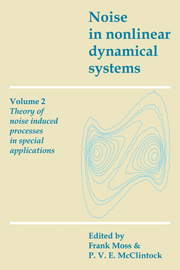Book contents
- Frontmatter
- Contents
- List of contributors
- Preface
- Introduction to Volume 2
- 1 Stochastic processes in quantum mechanical settings
- 2 Self-diffusion in non-Markovian condensed-matter systems
- 3 Escape from the underdamped potential well
- 4 Effect of noise on discrete dynamical systems with multiple attractors
- 5 Discrete dynamics perturbed by weak noise
- 6 Bifurcation behavior under modulated control parameters
- 7 Period doubling bifurcations: what good are they?
- 8 Noise-induced transitions
- 9 Mechanisms for noise-induced transitions in chemical systems
- 10 State selection dynamics in symmetry-breaking transitions
- 11 Noise in a ring-laser gyroscope
- 12 Control of noise by noise and applications to optical systems
- 13 Transition probabilities and spectral density of fluctuations of noise driven bistable systems
- Index
10 - State selection dynamics in symmetry-breaking transitions
Published online by Cambridge University Press: 05 January 2012
- Frontmatter
- Contents
- List of contributors
- Preface
- Introduction to Volume 2
- 1 Stochastic processes in quantum mechanical settings
- 2 Self-diffusion in non-Markovian condensed-matter systems
- 3 Escape from the underdamped potential well
- 4 Effect of noise on discrete dynamical systems with multiple attractors
- 5 Discrete dynamics perturbed by weak noise
- 6 Bifurcation behavior under modulated control parameters
- 7 Period doubling bifurcations: what good are they?
- 8 Noise-induced transitions
- 9 Mechanisms for noise-induced transitions in chemical systems
- 10 State selection dynamics in symmetry-breaking transitions
- 11 Noise in a ring-laser gyroscope
- 12 Control of noise by noise and applications to optical systems
- 13 Transition probabilities and spectral density of fluctuations of noise driven bistable systems
- Index
Summary
Introduction
In nature, states of broken symmetry are found at all levels, from the microscopic to the macroscopic. The state of a physical system is determined by – depending on the level of description – atomic and molecular interactions or by irreversible thermodynamic processes. We speak of a ‘broken symmetry’ if the state does not have the symmetries of the interactions or the processes that determine it; transitions to such states are the symmetry-breaking transitions. From a thermodynamic viewpoint, symmetry-breaking transitions can occur in systems in equilibrium as well as systems far from equilibrium. In equilibrium systems, magnetic transitions in crystalline solids are the best known examples (Briss, 1964; Cracknell, 1975). In nonequilibrium systems, such transitions are known to occur in hydrodynamic, chemical and laser systems (Haken, 1977; Nicolis and Prigogine, 1977). A most striking example of a state of broken symmetry is the ‘state of life’. The chemistry of life has a definite handedness: all proteins are made of L-amino acids and DNA and RNA contain exclusively d-sugars (Miller and Orgel, 1974). Biochemical function depends very delicately on this molecular chirality. d-amino acids are a rarity and they occur only as polypeptides (Bentley, 1969). Though there are many conjectures, the processes that resulted in a transition to such a state of broken chiral symmetry have not yet been identified.
- Type
- Chapter
- Information
- Noise in Nonlinear Dynamical Systems , pp. 251 - 270Publisher: Cambridge University PressPrint publication year: 1989
- 3
- Cited by

